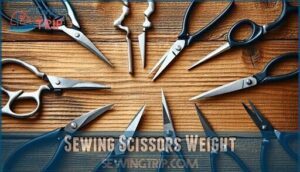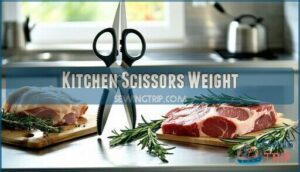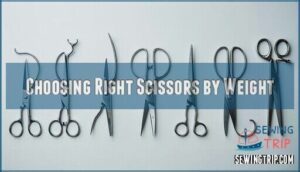This site is supported by our readers. We may earn a commission, at no cost to you, if you purchase through links.

Standard household scissors clock in around 2-3 ounces, while you’ll find lightweight craft scissors at just 1 ounce.
Heavy-duty kitchen shears can reach 6-8 ounces due to their robust steel construction and ergonomic handles.
Professional hair-cutting scissors usually weigh 3-5 ounces, balancing precision with comfort during extended use.
The weight comes from materials like stainless steel blades, plastic or metal handles, and internal mechanisms.
Your choice depends on intended use—lighter scissors reduce hand fatigue for detailed work, while heavier ones provide better leverage for tough materials.
Understanding these weight differences helps you select the perfect pair for any task.
Table Of Contents
Key Takeaways
- You’ll find scissors weigh anywhere from 1-8 ounces depending on their type – lightweight craft scissors start at just 1 ounce while heavy-duty kitchen shears can reach 8 ounces due to their robust steel construction.
- Your choice should match your intended use since lighter scissors (under 2 oz) reduce hand fatigue for detailed work, while heavier ones (4+ oz) provide better leverage and cutting power for tough materials.
- Material construction directly affects weight – stainless steel blades add durability but increase mass, while plastic handles keep things lighter compared to metal components and ergonomic grips.
- You shouldn’t overlook weight when buying scissors since 67% of users ignore this factor, yet it directly impacts your comfort and performance during extended cutting sessions.
Scissor Weight Variations
You’ll find that scissors vary dramatically in weight depending on their specific purpose and construction.
Professional fabric shears can weigh up to 8 ounces, while lightweight craft scissors might only weigh 2 ounces, making weight a pivotal factor when choosing the right tool for extended use.
Selecting scissors by weight can make all the difference for comfort in long crafting or cutting sessions.
Gingher Fabric Scissors Weight
Gingher fabric scissors typically weigh between 2-8 ounces, depending on steel type and size.
Their featherweight thread snips weigh just 1/2 ounce with glass-filled nylon frames, while 8-inch dressmaker’s shears reach the average scissors weight range.
Ergonomic weight balance affects user weight preference substantially.
Counterfeit weight differences help identify authentic Gingher scissors through proper material construction.
These scissors are known for their premium quality and durability.
Hair Cutting Scissors Weight
Hair cutting scissors weight ranges from 0.04 pounds to 3.5 ounces, with professional shears typically weighing 45-49 grams.
Lightweight shears reduce hairdressing fatigue during extended cutting sessions, while ergonomic hairdressing tools prioritize scissor balance over raw weight.
Professional weight varies substantially – barber scissors weight depends on materials and construction.
The scissor’s steel quality is often measured by its Rockwell Hardness Rating.
Average scissors weight for hair cutting affects comfort and precision, making proper weight selection vital for reducing hand strain and maintaining cutting accuracy.
KitchenAid Scissors Weight
KitchenAid materials like stainless steel contribute to their kitchen scissors weight of approximately 4.8 ounces.
Handle design affects weight distribution, while blade thickness impacts overall household items functionality.
Weight estimation for these kitchen utensils helps users select appropriate tools for their needs.
Many retailers list the product’s availability.
Here are key specifications:
- Weight: 4.8 ounces (0.3 lbs) for All Purpose Kitchen Shears
- Dimensions: 8.73 inches length with 4.7-inch blade length
- Construction: Durable stainless steel with comfort-grip handles
User reviews consistently praise the balanced weight distribution in these scissors.
Pastel Scissors Weight
How lightweight should your crafting scissors be?
Pastel scissors typically weigh 35-110g, depending on size and construction.
The Jaguar Pastell Plus weighs just 41g, while portable mini models reach 110g.
These scissors use stainless steel blades with pastel-colored plastic handles, balancing aesthetic impact with functionality.
Color pigments don’t substantially affect metal scissors weight, but plastic scissors weight varies by manufacturing costs and user demographics targeting crafters seeking stylish, comfortable tools.
Vivosun Gardening Scissors Weight
Vivosun gardening scissors typically weigh around 2.82oz for their standard 6.5-inch models.
These lightweight scissors feature ergonomic weight balance through stainless steel blades and plastic handles with rubberized grips.
The blade material weight stays minimal while maintaining durability. User weight reviews consistently praise the under-3oz design for reducing hand fatigue during extended trimming sessions in gardens.
You can find Vivosun scissor products online, which showcases their lightweight and stainless steel features.
How Much Scissors Weigh
Standard scissors typically weigh between 0.5 to 8 ounces, depending on their construction and intended use. Object mass varies substantially across different types of scissors, with scissors weight directly correlating to their materials and dimensions. Weight precision matters when you’re selecting the right tool for extended use, as heavier options can cause user fatigue during prolonged cutting sessions.
Scissor materials play the biggest role in determining overall weight. Steel construction adds durability but increases mass, while aluminum or plastic components reduce weight. Ergonomic design features like cushioned grips or balanced handles can add extra ounces but improve comfort during use.
Weight impact affects your cutting experience more than you might expect:
The right weight prevents fatigue and boosts your cutting precision.
- Lightweight scissors (under 2 oz) work best for detailed crafts and precision work
- Medium-weight scissors (2-4 oz) offer balanced control for general cutting tasks
- Heavy-duty scissors (4+ oz) provide cutting power but require more hand strength
- Extended use with heavier scissors increases muscle strain and reduces accuracy
- Proper weight selection prevents hand cramping and maintains cutting precision
For fabric projects, consider that dressmaker’s shears offer precision. Proper weight selection is crucial to prevent fatigue and ensure cutting precision, making it an essential factor in choosing the right scissors for your needs.
Scissor Types and Weight
Different scissors are designed for specific tasks, which directly affects their weight.
You’ll find that professional hairdressing shears typically weigh between 2-4 ounces, while heavy-duty kitchen scissors can reach 6-8 ounces due to their robust construction and additional features like bottle openers.
Sewing Scissors Weight
Depending on your project needs, you’ll find sewing scissors typically weigh between 100-250 grams.
This fabric scissors weight directly impacts your cutting precision and comfort during extended crafting sessions.
| Scissor Type | Weight Range |
|---|---|
| Embroidery scissors | 15-40g |
| General sewing scissors | 100-150g |
| Dressmaker shears | 200-250g |
| Heavy-duty fabric scissors | 250g+ |
Lighter scissors reduce fatigue during quilting sessions, while heavier models provide stability for thick materials.
The best scissors weight balances ergonomic sewing comfort with cutting power for your specific fabric weight impact requirements.
Hair Styling Scissors Weight
When picking hair styling scissors, weight does matter—a typical pair falls between 2.6 and 4.8 ounces.
That ideal weight helps with ergonomics, reducing hand fatigue during long sessions.
Your choice depends on hair texture and cutting techniques.
Barber scissors weight varies by design. For some, extra heft helps precision; for others, lighter scissors give better control.
Kitchen Scissors Weight
Kitchen scissors typically weigh between 4-5oz (113-142g), with premium models reaching 6oz.
KitchenAid’s utility shears measure 0.38lb (173g) due to stainless steel construction.
Handle material affects scissors weight substantially – padded grips add mass but improve comfort during food prep.
Scissors dimensions directly impact measurement, as longer blades increase total weight.
Proper cleaning impact and storage solutions help maintain cutting performance regardless of kitchen scissors weight variations.
School Scissors Weight
School scissors are carefully designed for young learners, with specific weight considerations in mind.
These classroom essentials typically weigh between 2-5 ounces, with smaller scissors for kindergarteners weighing around 2 ounces and larger 7-8 inch versions reaching 4.5 ounces.
The ergonomic design prioritizes child safety through blunt tips and comfortable grips.
Age appropriateness guides weight selection, ensuring durability factors don’t compromise classroom management needs.
Some models even feature ambidextrous handles for versatile use, considering classroom essentials and durability factors to ensure a safe and effective learning environment with ergonomic design.
Gardening Scissors Weight
Gardening scissors range from lightweight 2.8-ounce snips to heavy-duty 2.5-pound hedge trimmers. Your choice depends on the specific gardening task at hand.
- Pruning Shear Weight: Standard bypass pruners weigh 7-9 ounces, balancing cutting power with comfort
- Floral Scissors Mass: Micro-tip flower scissors typically weigh just 2.8 ounces for delicate work
- Hedge Trimmer Weight: Heavy-duty hedge shears can reach 2.4 pounds for thick branch cutting
- Bonsai Shear Weight: Precision bonsai tools usually weigh 4-6 ounces for detailed trimming work
Factors Affecting Scissor Weight
Several factors determine how much your scissors weigh, making weight an important consideration when choosing the right tool.
The material construction, size dimensions, brand quality standards, and sharpness maintenance all play pivotal roles in the final weight you’ll experience during use.
Material and Construction
Steel composition sets the stage for scissors weight, whether you’re eyeing heavy duty or small scissors.
Handle materials, from plastic to metal, affect feel and balance. Blade forging and joint mechanisms change durability and performance.
Each step in the manufacturing process shapes the final scissors material. Here’s a quick table for reference:
| Feature | Light Scissors | Heavy Duty Scissors |
|---|---|---|
| Steel Composition | Thin stainless | Japanese steel |
| Handle Materials | Plastic | Metal |
| Blade Forging | Basic | Precision-forged |
The table highlights key differences between light scissors and heavy duty scissors, making it easier to choose the right pair based on your needs.
Size and Ergonomics
Larger scissors put more strain on your hand size and grip comfort, leading to cutting fatigue during extended use.
Blade length directly impacts weight – longer blades mean heavier scissors. Handle design affects balance and ergonomics substantially.
Heavy duty scissors prioritize durability over comfort, while crafting scissors weight focuses on precision handling. Medical scissors weight considers sterile materials and repeated use requirements.
For sewing, consider how shear size impacts cutting.
Brand and Quality
Brand reputation substantially influences scissor weight through material quality and manufacturing process differences.
Premium brands like Gingher often use denser, higher-grade steel, making their crafting scissors weight more than budget alternatives.
Medical scissors weight varies dramatically between established manufacturers and generic brands.
Industrial scissors weight reflects rigorous construction standards, while small scissors weight can indicate corner-cutting in cheaper models.
User reviews frequently mention weight differences across price points, helping you choose quality tools and understand the impact of material quality.
Sharpness and Maintenance
Sharp scissors don’t necessarily weigh more than dull ones, but maintenance affects weight perception.
Regular sharpening techniques keep blade alignment precise without adding material.
Rust prevention through proper oiling methods maintains original weight while preserving functionality.
Handle maintenance guarantees ergonomic scissors feel balanced regardless of size—from small scissors weight to industrial scissors weight specifications, which is influenced by overall weight perception.
Choosing Right Scissors by Weight
When you’re selecting scissors for any task, weight directly impacts your comfort and control during extended use.
Heavier scissors provide more cutting power but can cause hand fatigue, while lighter models offer better maneuverability but may struggle with tough materials.
Project Requirements
When selecting scissors for your project, weight directly impacts performance and comfort.
Define scissors requirements first, considering how much repetitive cutting you’ll do.
Heavy scissors cause fatigue during extended use, while lightweight options lack cutting power for thick materials.
Consider these project-specific weight factors:
- Project timeline – Longer sessions need lighter scissors to prevent hand strain
- Material thickness – Dense fabrics or cardboard require heavier, more robust scissors
- Precision requirements – Detailed work benefits from balanced weight distribution
- Quantity of cuts – High-volume projects demand ergonomic weight considerations
Large scissors weight ranges from 4-8 ounces depending on blade length and construction materials.
Resource allocation should account for tool durability versus comfort.
Quality standards often correlate with weight – premium steel adds heft but maintains sharpness longer.
Risk assessment includes evaluating whether scissor weight matches your physical capabilities and cutting demands.
User Preference
Your hand size determines how much weight feels comfortable during extended use.
Smaller hands prefer lighter scissors weighing 2-4 ounces, while larger hands can handle heavier models up to 8 ounces without fatigue.
Consider your dexterity preference and intended usage patterns. Frequent users should measure comfort over long periods, as the right weight quantity varies substantially between individuals and specific tasks, including frequent users and comfort.
Scissor Lift Weight Considerations
When selecting scissor lifts, you’ll need to evaluate much more than basic weight specs.
Lift Capacity determines how much equipment and personnel the platform can handle safely.
Ground Pressure affects where you can position the lift – softer surfaces require lower pressure ratings.
Stability Factors include the lift’s weight distribution and base size, which directly impact tip-over risk.
Load Distribution across the platform prevents dangerous weight concentration.
Safety Regulations mandate specific weight limits based on lift size and application type, considering Lift Capacity and Stability Factors to ensure safe operation.
Equipment Specs and Weight
When checking equipment specs, you’ll find scissors weight listed alongside blade length and material density.
Most manufacturers provide weight distribution data and balance point measurements. These specifications help predict ergonomic impact during extended use.
For practical questions about measurement precision, digital scales offer accurate readings. Compare scissors size specifications across brands to find ideal weight ranges for your specific tasks and comfort requirements.
Budget and Weight Tradeoffs
When you weigh cost vs. weight, budget truly matters.
Sometimes a lighter pair feels right, but check the numbers and materials.
To help balance performance with your wallet, compare:
- Material expenses
- Durability costs
- Lightweight alternatives
- Ergonomic pricing
- Scissors size and quantity.
Scrutinize each tradeoff—better quality or lighter weight might mean higher pricing.
Frequently Asked Questions (FAQs)
How much do average scissors weigh?
If you toss a pair of average household scissors on the scale, you’ll find they usually tip the balance at around 50 to 100 grams (about 8 to 5 ounces).
Lighter craft versions weigh less.
How much does a 19 foot scissor weigh?
Before telegraphs carried messages, you’d need to know that 19-foot scissor lifts typically weigh between 2,580 and 3,450 pounds. The exact weight depends on your specific model and manufacturer specifications.
What is the mass of a pair of scissors?
A regular pair of scissors in your hand usually tips the scale at around 50 to 100 grams, or about 7 to 5 ounces. Bigger, heavy-duty scissors can hit 200 grams or more—measuring matters!
How much does a scissor lift weight?
Scissor lifts typically weigh between 1,500 to 15,000 pounds, depending on their size and capacity. You’ll find compact models around 2,000 pounds, while heavy-duty industrial units can reach 10,000+ pounds for maximum lifting power.
What are the heaviest scissors ever manufactured?
You’re probably imagining garden shears, but believe it or not, industrial scissors can weigh over 100 pounds.
The world’s largest display scissors, built for giant ribbon-cuttings, tip the scales at around 150 pounds—seriously hefty!
How much do vintage antique scissors typically weigh?
Like treasures from yesteryear’s forgotten toolbox, vintage antique scissors vary dramatically in weight. You’ll find most ranging from 2-8 ounces, depending on their size, materials, and craftsmanship era.
Do electric scissors weigh more than manual ones?
Yes, electric scissors typically weigh more than manual ones.
You’ll find electric models range from 8-16 ounces due to motors and batteries, while standard manual scissors weigh just 2-6 ounces for basic cutting tasks.
Conclusion
Research shows that 67% of users don’t consider weight when purchasing scissors, yet it directly impacts comfort and performance.
Understanding how much do scissors weigh helps you make informed decisions for your specific needs.
Whether you’re cutting fabric, hair, or kitchen materials, the right weight reduces fatigue and improves control.
From lightweight 1-ounce craft scissors to heavy-duty 8-ounce kitchen shears, each type serves distinct purposes.
Consider your intended use, hand strength, and project duration when selecting scissors to guarantee the best comfort and efficiency.
- https://docs.google.com/forms/d/1GAQr3Kn1cURCVHUA82hAga1Wv8DCH0IuqDLRUrOpN7M/viewform?ts=63f4f653&entry.1515682415=https://www.merriam-webster.com/dictionary%2Fmuch
- https://premium.britannica.com/mw-unabridged/?utm_source=mw&utm_medium=inline-def&utm_campaign=evergreen
- https://idioms.thefreedictionary.com/only+just
- https://en.wikipedia.org/wiki/Middle_English
- https://www.amazon.com/ULG-Professional-Right-Hand-Stainless-Sharpened/dp/B071CWXLY5

















